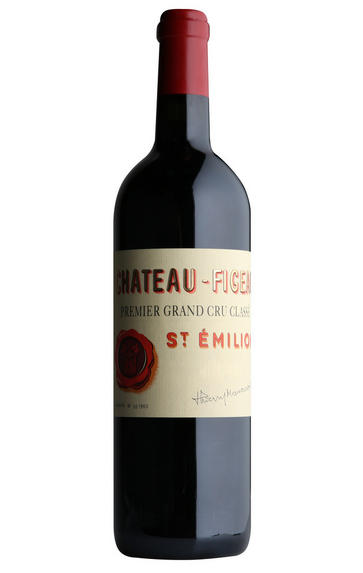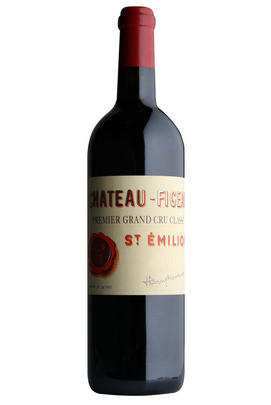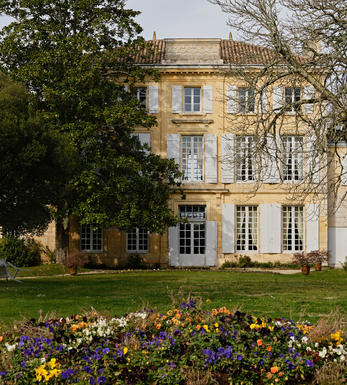
2022 Château Figeac, St Emilion, Bordeaux

Critics reviews
The 2022 Figeac was picked between 1-26 September with a pH of 3.7 and 14% alcohol. This wine combines both Left Bank and Right Bank traits due to its blend (as usual), but this year leans more to the Right Bank despite a slightly lower contribution of Cabernet Sauvignon. It is very well defined, fresh and shows lively black fruit, incense and nuanced Chinese tea aromas.
The palate is beautifully balanced with a lightly spiced entry, fine depth and plenty of concentration counterbalanced by finesse toward the graphite-infused finish. Its saline aftertaste beckons you back for another sip. An appropriate way to start your tenure as a Grand Cru Classé “A”.
Drink 2032 - 2070
Neal Martin, Vinous.com (April 2023)
The 2022 Figeac is a magnificent, super-classic Figeac, as odd as that might sound in this freakish vintage. A wine of sublime delicacy and nuance, the 2022 possesses tremendous aromatic presence, finely sculpted fruit and phenomenal persistence. I especially admire the wine’s freshness, energy and clean, mineral finish.
The 2022 is a towering Figeac, a wine that brilliantly showcases the unique qualities of this site. Figeac is a rare Right Bank estate with gravel and blue clay soils not often found here, planted approximately with equal parts Merlot, Cabernet Franc and Cabernet Sauvignon.
Drink 2032 - 2052
Antonio Galloni, Vinous.com (April 2023)
Vibrant damson in colour, edges of gunsmoke and red rose petals on the aromatics, as you so often find in Figeac, with dense cassis, black cherry, incense, graphite, slate, mint leaf, cocoa bean, cappuccino and liquorice on the palate. This is creamy but airy and full of joy.
Close to the 2016 vintage in its construction and effortless confidence, no question of the ageing ability of this wine, and a fine vintage to mark the first year as Premier Grand Cru Classé A. Breaking down how they got here, you find inevitably careful winemaking with no pumping over, cool 26C for fermentation, making use of techniques learnt in the hot, dry summer of 2018, from cover crops to minimum green harvesting.
Blend finished including 8% press in March, 3.7ph, harvest began September 1, earliest on record, until 26, second vintage in the new winery. Frederic Faye, director.
Drink 2032 - 2050
Jane Anson, JaneAnson.com (May 2023)
35% Merlot, 34% Cabernet Franc, 31% Cabernet Sauvignon. Cask sample.
A signature Figeac, the Cabernet coming through on the nose and palate. Floral, cassis and graphite notes. Plenty of energy, the fruit juicy and rich but not excessive. Ripe, abundant tannins behind. Long, persistent finish. Just a hint of oak in the background.
Drink 2032 - 2050
James Lawther MW, JancisRobinson.com (May 2023)
A blend of 35% Merlot, 34% Cabernet Franc and 31% Cabernet Sauvignon, the 2022 Figeac is a brilliant wine with which to celebrate this property’s elevation to Premier Grand Cru Classé A status. Wafting from the glass with aromas of raspberries, and cassis mingled with notions of iris, forest floor, cigar wrapper and pencil lead, it’s medium to full-bodied, pure and perfumed, with a deep and multidimensional core of fruit, bright acids and beautifully refined tannins.
Serious yet civilized, it’s the quintessential Figeac, a testament to the late Thierry Manoncourt’s vision to plant a large proportion of Cabernet on drought-resistant rootstocks. Such is the inherent complexity of Figeac’s terroirs that harvest took place sub-block by sub-block between September 1st and 25th. Congratulations are for the Manoncourt family, director Frédéric Faye, consulting winemaker Thomas Duclos and all their team.
William Kelley, Wine Advocate (April 2023)
This is the earliest-ever harvest for Figeac, and the fruit is something else. Flowers such as violets. Blackberries. Currants. Cherry blossom. Full-bodied with lovely freshness and depth. Crunchy and juicy. Perfect al dente fruit. 35% merlot , 34% cabernet franc and 31% cabernet sauvignon.
James Suckling, JamesSuckling.com (April 2023)
An incredibly impressive wine in 2022, shaping up to be the wine of the vintage, as it seems to defy the hot and dry conditions in every way but delivers such confidence and charm that it makes it hard to resist. Gorgeous aromatic expression on the nose, open and alive, generous scents of bright bramble fruit, floral notes, and graphite and cedar.
Smooth, supple and generous on the palate, tannins are silky and perfectly weighted, giving roundness but also structure with a red berry juiciness and saline bite that is so compelling. Vibrant, dynamic, balanced and precise, the energy is outstanding, yet depth, weight and power are still underneath. There’s not a single thing out of place - utterly seductive and totally moreish.
A great effort from the estate now proudly displaying their upgrade to St-Emilion Premier Grand Cru Classé A for the first time as of the new classification. 3.7pH. 8% press wine. 82% grand vin production. Harvest 1 - 26 September, the earliest ever.
Drink 2039 - 2050
Georgina Hindle, Decanter.com (April 2023)
A beautiful wine that, shockingly, reminds me of the 2016, the 2022 Château Figeac checks in as 35% Merlot, 34% Cabernet Franc, and 31% Cabernet Sauvignon that was harvested from the 1st of September to the 25th. Director Frédéric Faye commented that verasion took longer than usual, and they had to do a slight green harvest to get uniform ripeness. The results are stunning.
The wine has a vivid purple hue and remarkable freshness and purity in its black and blue fruits, followed by notes of wild herbs, chocolate, graphite, spring flowers, and a touch of classic Cabernet Sauvignon graphite. It is medium to full-bodied on the palate and has a silky, elegant mouthfeel, beautiful tannins, and a great finish.
Given its purity and balance, this classic, ultra-precise Figeac will warrant a solid decade of bottle age and be very long-lived.
Jeb Dunnuck, JebDunnuck.com (May 2023)
About this WINE

Château Figeac
Château Figeac is one of the leading St. Emilion estates and its wine, with its high Cabernet content, has often been described as the most Médoc-like in St-Emilion. The estate is located in the north-west of the appellation with its vineyards adjoining those of Cheval Blanc. Its 54 hectares of vineyards lie on a deep, Médoc-like gravel topsoil over a flinty, iron-rich subsoil. Figeac was promoted in 2022 to the level of Premier Grand Cru Classé A, the top tier of the St Emilion classification.

St Émilion
St Émilion is one of Bordeaux's largest producing appellations, producing more wine than Listrac, Moulis, St Estèphe, Pauillac, St Julien and Margaux put together. St Emilion has been producing wine for longer than the Médoc but its lack of accessibility to Bordeaux's port and market-restricted exports to mainland Europe meant the region initially did not enjoy the commercial success that funded the great châteaux of the Left Bank.
St Émilion itself is the prettiest of Bordeaux's wine towns, perched on top of the steep limestone slopes upon which many of the region's finest vineyards are situated. However, more than half of the appellation's vineyards lie on the plain between the town and the Dordogne River on sandy, alluvial soils with a sprinkling of gravel.
Further diversity is added by a small, complex gravel bed to the north-east of the region on the border with Pomerol. Atypically for St Émilion, this allows Cabernet Franc and, to a lesser extent, Cabernet Sauvignon to prosper and defines the personality of the great wines such as Ch. Cheval Blanc.
In the early 1990s there was an explosion of experimentation and evolution, leading to the rise of the garagistes, producers of deeply-concentrated wines made in very small quantities and offered at high prices. The appellation is also surrounded by four satellite appellations, Montagne, Lussac, Puisseguin and St. Georges, which enjoy a family similarity but not the complexity of the best wines.
St Émilion was first officially classified in 1954, and is the most meritocratic classification system in Bordeaux, as it is regularly amended. The most recent revision of the classification was in 2012

Cabernet Sauvignon Blend
Cabernet Sauvignon lends itself particularly well in blends with Merlot. This is actually the archetypal Bordeaux blend, though in different proportions in the sub-regions and sometimes topped up with Cabernet Franc, Malbec, and Petit Verdot.
In the Médoc and Graves the percentage of Cabernet Sauvignon in the blend can range from 95% (Mouton-Rothschild) to as low as 40%. It is particularly suited to the dry, warm, free- draining, gravel-rich soils and is responsible for the redolent cassis characteristics as well as the depth of colour, tannic structure and pronounced acidity of Médoc wines. However 100% Cabernet Sauvignon wines can be slightly hollow-tasting in the middle palate and Merlot with its generous, fleshy fruit flavours acts as a perfect foil by filling in this cavity.
In St-Emilion and Pomerol, the blends are Merlot dominated as Cabernet Sauvignon can struggle to ripen there - when it is included, it adds structure and body to the wine. Sassicaia is the most famous Bordeaux blend in Italy and has spawned many imitations, whereby the blend is now firmly established in the New World and particularly in California and Australia.


Buying options
Add to wishlist
Description
This is a vintage to engage followers of the more delicate mid-1980s to early 2000s era, following the sequence of outstanding but highly detailed and superbly polished wines of recent years. All elements of modern Figeac are brilliantly expressed here, but there is also transparency that lifts the wine to a higher plane.
Merlot brings its delicious red fruit to the blend; Cabernet Franc contributes perfume and lift; Cabernet Sauvignon brings its architecture and notes of mint and warm herbs. Frédéric Faye and his team have opened their eyes during the recent hot years, enabling this terroir’s full expression.
Merlot 35%; Cabernet Franc 34%; Cabernet Sauvignon 31%
Drink 2030 - 2050
Score: 19/20
Berry Bros. & Rudd (April 2023)
wine at a glance
Delivery and quality guarantee